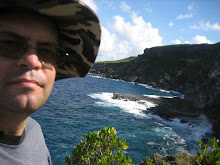

I saw one truck that recently went off the side. It landed hundreds of feet below the road, upside down, and half buried. The salvage crew arrived and started to retrieve the cargo with cables and a winch. When we passed by again on our return trip, the salvage crew was still pulling up large, perhaps 500 gallon, round sealed containers. The containers were, understandably, dented on every side but surprisingly still intact. They already retrieved perhaps 20 of these containers and lined them alongside the already narrow road. Unfortunately, I was not able to see what was in the containers. Our guide said that not only trucks go over the side but buses as well. That was sad because there had to be over 40 passengers on each bus.
Our goal for this trip was to visit the last area in the Philippines where the very unique and traditional natives to the islands lived. They are of a different race from the Filipinos who migrated there from elsewhere.
Our guide and the driver of the jeepney I rented for the trip had been there before and told me the history of the native village. The ancestors of this village originally lived on the coast. Three hundred, or so, years ago the Spanish arrived to the island and tried to convert and civilize all natives they could find, as they did on nearly all islands in the Pacific. The Spaniard's mission was to convert all they can and kill all they can't convert. This particular tribe wanted to keep their traditional culture so were forced to retreat deep into the mountains where they lived, culture intact, for the past 300 years.
I was becoming more anxious to get there with every word as I glanced out the window at the thousand-foot drop. Racing on the edge seemed to become less fearful as the hours passed. I came to the conclusion that it didn't matter if it was a 30 foot drop or a 3,000 foot drop although the 3,000 foot drop offered much better views.
Our guide continued his stories about the unique and beautiful people that we were about to meet. "They eat monkeys", said the guide. Not all his stories about the natives were pleasant. The guide continued, "The monkeys sound like they are crying when they are cooked." I then made plans to make myself scarce during meal times. Even still, I couldn't wait to get there.
I thought this was finally going to be worth the extreme risk to all our lives and the countless hours of pain from riding in the back of a jeepney, which I can only compare to a paint mixer at a hardware store.
Finally we arrived in the 300-year-old village of Sagada, the location of last tribe of pure and traditional natives of the Philippines. This turned out to be the biggest disappointment and the saddest. We arrived too late. Sometime after our driver and our guide's last visit to the village and our arrival, the Manila Urbanization Monster attacked. It destroyed the traditional village, the culture, and even the natives and turned the area into what looked like another suburb of Manila. All the Filipinos walking the paved street were texting on their cell phones.

A few years ago the Discovery Channel did a documentary on this unique and traditional tribe. Word must have got out and Filipinos migrated to the tribe by the thousands to capitalize on what the outside world found to be very interesting and special. In doing so they destroyed the last traditional culture of the Philippines. Today only statues of the villagers could be seen in the restaurants, hotels, and stores.
Besides the modern statues and the old rice terraces, there was no surviving evidence that the village or natives ever existed, above ground anyway. The next day I was ready to hightail it out of the mountain province when a 10 year-old Filipino boy offered to guide us to some burial caves that the traditional natives used.

Now that was interesting. All the caves we looked in were full of coffins. Some coffins were slightly old but most were very old, perhaps 300 years old. The old coffins were made from a full hollowed out tree trunk. The body was placed inside and the carved out hole was covered with a flat wood lid with carvings of large lizards. One large cave must have had a hundred of coffins carefully stacked 20 high. Another cave had some coffins suspended off the ground. One of those suspended coffins shifted over the centuries and the skeleton slid out and still lays where it fell on the ground below the coffin. The not-as-strong lid on many other coffins had decayed or just fell apart exposing the skeleton inside.
I was excited to explore these caves and imagined the history behind what I was seeing. Then I saw a sign. The sign was in English and quickly brought me from my imaginations of 300 years ago back to the present day. The sign said, "NOTICE. Please do not get anything inside. Don't open the coffins". The thought of people today doing that and destroying the last artifacts and even the human remains of this last native tribe was more than I could handle.

The coffin on the bottom right says "PUTI" which means "WHITE". A 10-year-old boy there told us that it was an Italian missionary who fell from the high cliff overlooking these coffins last year, so they buried him on the wall with the others that he was watching when he fell.



.
.
.
Read more of "My Adventures" on the top right of this page.

No comments:
Post a Comment